With the recent launch of new GPUs from both AMD and Nvidia, it’s time to take a look into what graphics cards are the best value right now, using the most up to date pricing in several regions. Since our last update, graphics card pricing has changed a lot for many older GPUs, some products are no longer in stock, and of course, we hadn’t yet had a chance to see how GPUs like the GeForce RTX 4090 and Radeon 7900 XTX stacked up compared to the entire array of available GPUs including more mainstream models.
Compared to last year we think we’re in a much better position to be judging the value of GPUs and whether you should buy them right now as we’re five launches deep into a new generation and have a pretty good idea what they are offering at the high end. Throughout most of 2022 our recommendation was to wait for pricing adjustments or new GPUs in the high end market, with only the lower segments being consistently worth buying.
Today’s article will be a cost per frame analysis based on benchmark data from the previous article and updated to include newer GPUs. The six games we’ve chosen for this comparison were picked carefully from our 50 game sample to be generally representative of how each card performs. Those games are Red Dead Redemption 2 using medium settings, Rainbow Six Siege using medium settings, Far Cry 6 medium, Hitman 3 medium, Dying Light 2 medium and Shadow of the Tomb Raider at the high quality preset. We won’t go over each game individually, but use average data calculated using a geomean which gives us a summary of the performance of each card, which we can then use for comparing the cost per frame.
The reason we are using medium quality settings is to feature both entry-level and high-end GPUs on the same charts. Today’s entry-level cards, think Radeon 6500 XT, aren’t exactly geared towards gaming using high quality settings, so medium is the limit for those cards. Meanwhile, higher tier models typically fare just fine on medium, though of course many people will choose to playing using ultra. We also have some 4K resolution data which will be most useful for high end cards.
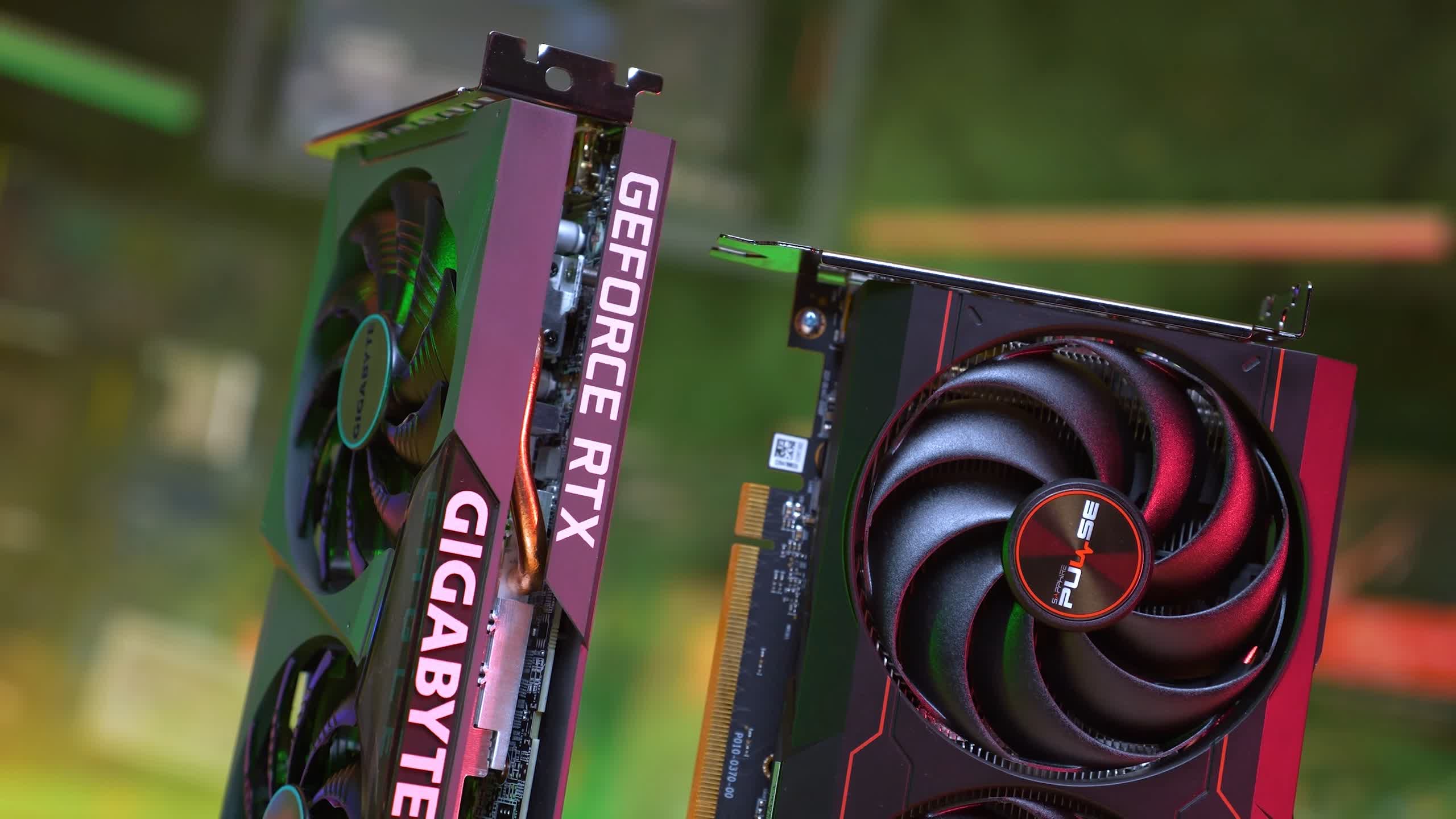
All testing was conducted using a Ryzen 7 5800X3D with DDR4-3600 CL16 memory and resizable BAR enabled, which is a setup that minimizes CPU bottlenecks as best as possible, especially when testing at 1080p. Also please note that the pricing information discussed here was taken over the last few days, and naturally pricing may have moved slightly, though in general it should remain accurate. Get prepared for a pretty graph-heavy analysis, so here we go…
Cost Per Frame: 4K, US MSRP
We’ll get started by looking at MSRP pricing in the US market using our 4K data. This is what various graphics cards should be priced at if they were still using launch prices, and gives us an idea of what each company was intending. What’s interesting here is that the RTX 3060 Ti is clearly the best value product across the last two generations if everything was at MSRP.
The RTX 3060 also fares well, with other products around that $400 mark not offering a compelling experience. For example, the Radeon 6600 would have offered a 17% higher cost per frame than the RTX 3060 in an MSRP market, which is why it got trashed in reviews. But things are very different today.
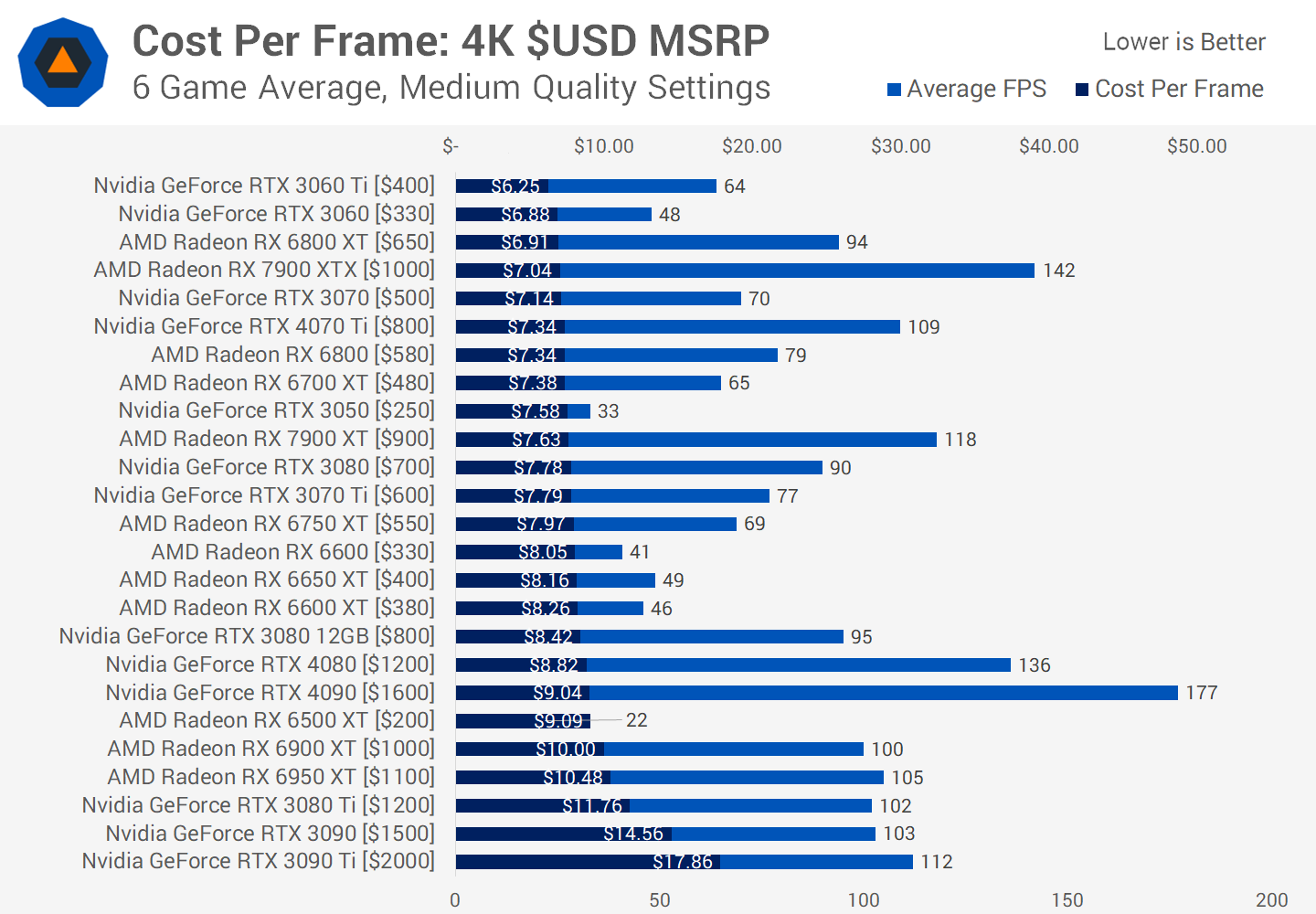
Also interesting to note is that the Radeon 7900 XTX looks reasonably favorable here with a cost per frame of $7.04, which as we’ve said in our day-one reviews is the best value of the new generation. The GeForce RTX 4070 Ti is slightly worse, offering 4% higher cost per frame. But the issue with these models is that value isn’t substantially better than last generation high end models and both cards could slot into the old product series. The 7900 XTX cost per frame is basically the same as the 6800 XT at MSRP, as it offers 51% more performance at a 54% higher price. The RTX 4070 Ti offers the same cost per frame as the RTX 3070 with its 56% higher performance for a 60% higher price.
This captures why so many have been left with a sour taste in their mouth with this new generation. And it only gets worse for the other models, the Radeon 7900 XT is in no mans land with worse cost per frame than the XTX, and the RTX 4080 and RTX 4090 are rather poor value – though admittedly better value than previous-gen flagships.
Cost Per Frame: 1440p, US MSRP
These charts are even less favorable when looking at 1440p performance. At 4K the Radeon 7900 XTX’s MSRP looked okay, but it falls into the middle of the pack at 1440p, as does the RTX 4070 Ti which now offers slightly better value. But beating all these cards are previous generation offerings at their MSRP, such as the Radeon 6800 XT, RX 6800 and GeForce RTX 3070.
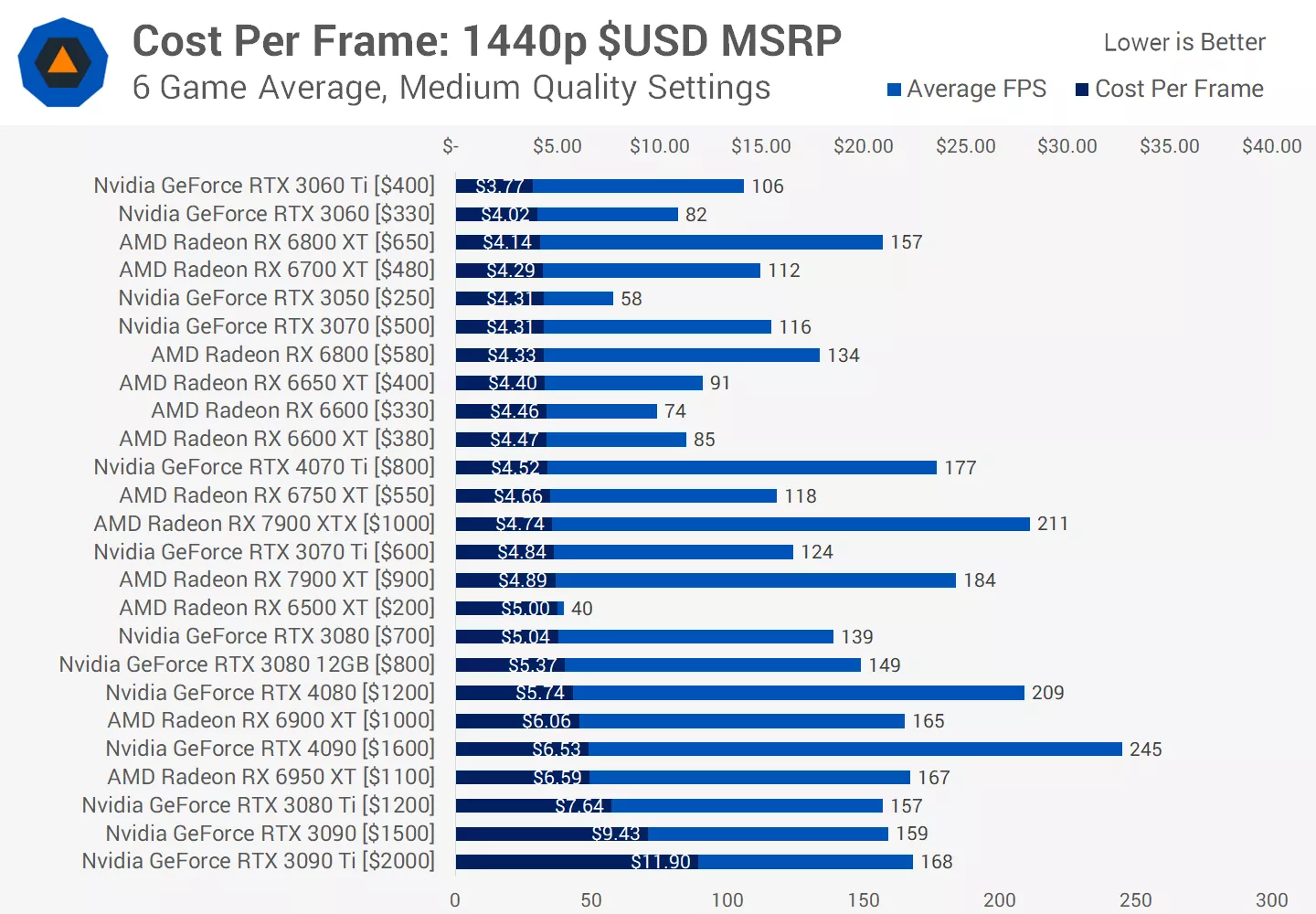
But the MSRP of these cards isn’t that relevant in today’s market as GPU pricing has changed, so let’s revisit this data using current GPU pricing collected from US retailers such as Newegg, Amazon and Microcenter – using the lowest available pricing.
Cost Per Frame: 4K, US Current Pricing
What’s clear from gathering this data is there’s been a push to rid the market of high end previous generation models. The RTX 3090, RTX 3080 Ti and RTX 3080 12GB are all in low supply and sitting well above their previous ‘best’ price, so shouldn’t be considered. This has the effect of making some models from the new generation look better.
If we start with a focus on the high end, both the RTX 4090 and RX 7900 XTX are only available well above their MSRP at the moment, which makes them terrible buys. The RTX 4090 at over $2,000 is a horrendous deal and no better value than older high end cards like the RTX 3080 Ti, though admittedly it is a much faster GPU. The Radeon 7900 XTX is also impossible to recommend at $1,300 — supply of the $1,000 models has dried up and for $1,300 its value equation is bad, coming in with equivalent cost per frame to the GeForce RTX 4080, which is available at its awful $1,200 MSRP.
All of these GPUs are placed in much worse value than previous high-end models. For example, the Radeon 6950 XT at $700 has 37% better cost per frame than the 7900 XTX – ouch! This AMD flagship from the RDNA2 era also beats the RTX 4070 Ti and RX 7900 XT by 11% in terms of cost per frame, making it the clear standout option in the $700+ market and the only GPU you’d consider from a value standpoint. With that said, it’s interesting how in the current market, the tables have flipped on the 7900 XTX vs 7900 XT, with now the XT model clearly the better choice – though hardly a standout.

For high end buyers, simply targeting a price isn’t everything though, and we think you wouldn’t necessarily be considering a Radeon 6950 XT instead of a GeForce RTX 4090 even though the 6950 XT is the best value GPU priced at or above $700. The RTX 4090 is nearly 70% faster at 4K, with the RTX 4080 and 7900 XT around 30 to 35% faster. There’s still reason to buy these more expensive models for their performance, it’s just that you won’t be getting a good deal, and it stings to see the RTX 4080 basically being the best model in cost per frame for 4K gamers wanting to max out a high refresh rate display.
There’s still reason to buy more expensive models for their performance, it’s just that you won’t be getting a good deal, and it stings to see the RTX 4080 basically being the best model in cost per frame for 4K gamers wanting to max out a high refresh rate display.
In the middle of the market, we don’t have new GPUs targeting $400 to $600 yet so we’re stuck with older graphics card models, but luckily most are still in stock. Around this price range, AMD does have an advantage at the moment with deep discounts for RDNA2 products making them worth buying.
The Radeon RX 6750 XT and RX 6800 are the two standouts here, especially the 6750 XT. At around a 60 FPS average at 4K it offers 5% cheaper cost per frame than Nvidia’s best option, the RTX 3060 Ti. Value is also worlds better than the RTX 3070 and RTX 3070 Ti which also sit in this price range, really you wouldn’t consider those models at the moment if you had about $500 to spend, you’d grab the Radeon 6800 which is cheaper and faster than the RTX 3070.
Cost Per Frame: 1440p, US Current Pricing
This is also true at 1440p. The Radeon 6750 XT maintains an 8% cheaper cost per frame relative to the RTX 3060 Ti. The GeForce 3070 and 3070 Ti just aren’t worth considering, as a 35% higher cost per frame compared to the RX 6800 is too great of a discrepancy even when factoring in ray tracing performance and other Nvidia exclusive features.
What’s great about AMD GPUs in the mid range is that their value isn’t significantly worse than mainstream models in the sub $400 category. If you grab a Radeon 6750 XT for $410, its cost per frame is only 15% higher than the 6650 XT – or just 6% higher for the 6700 XT. Nvidia’s situation conversely is that the RTX 3060 Ti is not a class leading value option, but it’s their best value product right now for 1440p gamers. The RTX 3060 and RTX 3050 – both of which still aren’t at MSRP yet – are worse value and in the case of the 3050, quite considerably so.

This hands AMD an easy win for buyers looking to spend $200 to $300 on a graphics card. The Radeon 6650 XT is not only faster than the RTX 3060 at 1440p, it’s also 27% cheaper in cost per frame. Similarly, the Radeon 6600 is much faster than the RTX 3050, yet offers a whopping 36% discount in cost per frame.
This sort of pricing for mainstream RDNA2 is going to put real pressure on next-gen entry-level GPUs as pricing has already been slashed compared to MSRP, and all models are sitting at tier-below pricing. We’d need to see basically two tiers worth of improvement from a next-gen card. When briefly looking at 1080p, AMD is only able to extend their lead on Nvidia cards in terms of value and really there’s no Nvidia GPU worth considering at this resolution at any price at or below $500.
Cost Per Frame: 4K and 1440p, Australia Current Pricing
What about other regions? Well, let’s take a look at value in Australia, using the latest data from PC Case Gear. Unlike in the United States where some models in low stock are still being sold at scalper prices, there’s a large chunk of models (mostly in the high end) that are simply out of stock or removed from listings. This includes most of the previous generation high end from AMD and Nvidia, which does disrupt the high end market as you can no longer purchase a great value Radeon 6800 or RX 6800 XT.
In Australia, looking at our 4K average data, the best value high end GPU is the AMD Radeon 7900 XTX. If you have well over $1,500 to spend, it’s the card that makes the most sense, with superior cost per frame compared to the RX 6950 XT. With that said, locally the 7900 XT is priced 29% higher for 35 percent more performance on average, which is hardly a standout and continues the pricing issue for new models that we saw in the US market. The RTX 4080 and RTX 4090 are especially poor value in Australia, failing to get near the RTX 3080 in cost per frame, which is the most reasonably priced previous generation high end model that’s actually still available.
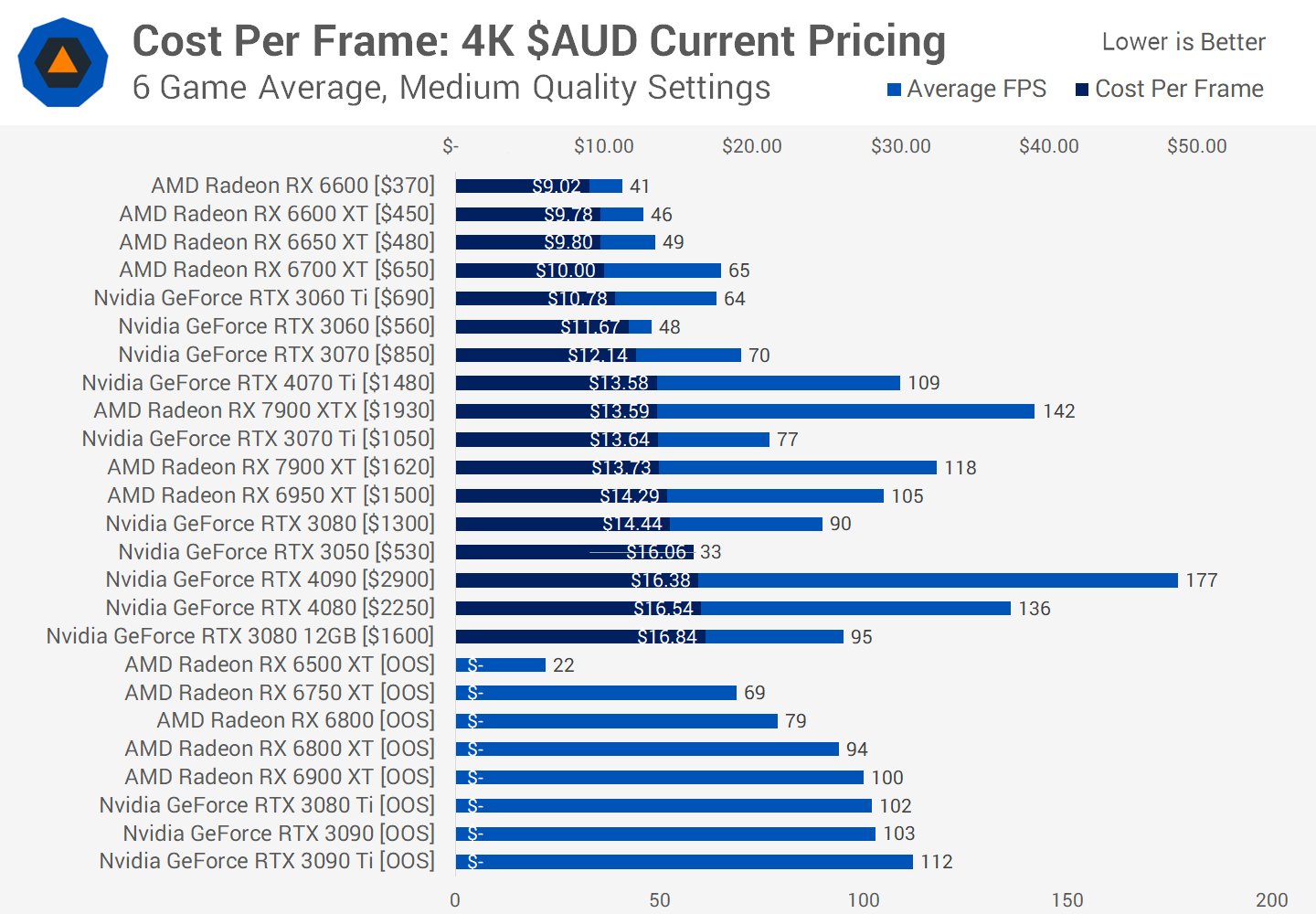
A step below the 7900 XTX in the high end would be cards priced around $1,500 Aussie, which like in the US is the battle between the Radeon 7900 XT and GeForce RTX 4070 Ti. Pricing for Nvidia’s newest GPU is actually quite reasonable in Australia considering the price of the RTX 4080 and its value. The RTX 4070 Ti is cheaper, and is therefore able to equivalent cost per frame, which when you add in Nvidia’s other features does make it the better buy.
People looking for more of a mid-range GPU will find the standout value choice is the Radeon 6700 XT, which is similar to what we saw in the United States. The 6700 XT offers 7% cheaper cost per frame than the GeForce RTX 3060 Ti and an 18% discount on the RTX 3070 per frame, all of which perform in a similar tier. This lead is extended slightly if you are more interested in 1440p than 4K gaming; the Radeon option performs better relative to the GeForce options at this resolution.

AMD is also offering by far the best value models for entry-level and mainstream buyers in Australia. The Radeon 6650 XT dominates the RTX 3060 by offering better performance at 1440p but with an $80 discount, leading to a 19% cheaper cost per frame. The RTX 3050 is such horrific value its position in the 1440p chart is embarrassing, coming in worse than the 7900 XT and around the mark of the RTX 3080. 1080p gamers should also really only be considering AMD GPUs in the mainstream at this point.
Cost Per Frame: 4K and 1440p, Europe Current Pricing
Over in Europe the situation for value is similar to other markets. High end shoppers are faced with inflated pricing for the two models you’d probably be considering the most in the GeForce RTX 4090 and Radeon 7900 XTX, which are nowhere near MSRP at the moment.
This hurts their value and while the 7900 XTX is able to offer better cost per frame than the RTX 4080 in Europe at the moment – a better situation than in the US – it’s not as favorable for the Radeon card as in Australia and overall offers pretty average value. The Radeon 7900 XT is a much better buy and comes in with slightly better cost per frame than the 4070 Ti for those looking at a high end experience, but both are beaten by the Radeon 6950 XT which delivers a 5 percent discount per frame than the 7900 XT.
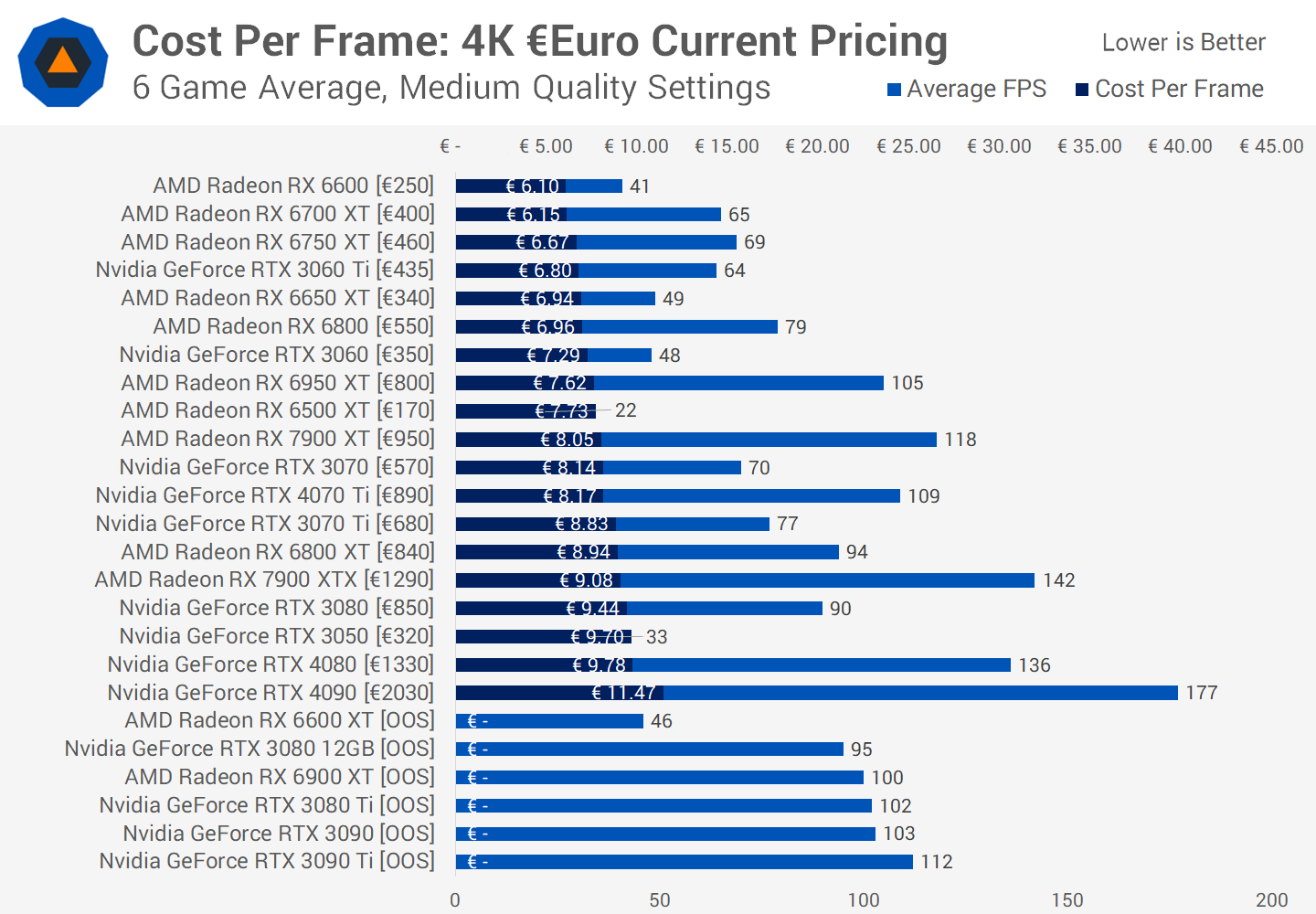
Like the other regions, it’s not exactly a pretty picture for people wanting to buy in the 800 Euro-plus price range, the new options on the market are fairly mediocre in terms of value and are often beaten or equivalent to previous-gen high end models.
The good news is that mid-range European shoppers are treated to the same discounted AMD pricing as in the US and Australia. This makes the Radeon 6700 XT the standout buy over the RTX 3060 Ti, which here is also the best value Nvidia product. The RDNA2 card offers 10% cheaper cost per frame, which is the best value proposition in favor of AMD in this price class across the regions we’ve looked at. Same story at 1440p where the Radeon 6700 XT is faster and cheaper than the GeForce RTX 3060 Ti.
For mainstream shoppers it’s similar to other regions where the Radeon RX 6600 and RX 6650 XT are far and way the best choice compared to the RTX 3060 and RTX 3050 in the below 400 euro price category. There is no reason to purchase the GeForce RTX 3060 that offers 14% higher cost per frame than the 6650 XT, while the RTX 3050 is atrocious value.

Across all of these markets the pricing of the 3050 is honestly quite bizarre, it’s just really really bad and the Radeon 6500 XT is often not particularly well priced either, but there’s just something about the RTX 3050 that has repelled good pricing since its launch. Even at 1080p you just can’t make a case for buying the RTX 3050, even if you were interested in Nvidia’s exclusive features and gave them fair consideration.
What We Learned, a Next-gen Mythical $500 GPU
That’s where GPU value is currently sitting across three regions and while there are a few differences between the US, Europe and Australia, we’re seeing similar trends in each market segment.
The mainstream market is looking good at the moment in terms of overall value, with cards in the sub-$300 range offering the best value overall. AMD continues to be aggressive on pricing with cards such as the Radeon RX 6600 sitting nearly a full tier below MSRP, which definitely makes them worth considering as we wait for next-generation cards.
Based on pricing from the latest high-end releases, it doesn’t seem like we’ll be getting much of an improvement in cost per frame this generation (at least for now), so we think it’s relatively safe to buy something like an Radeon 6600 knowing it’s unlikely to be significantly beaten by a new model.
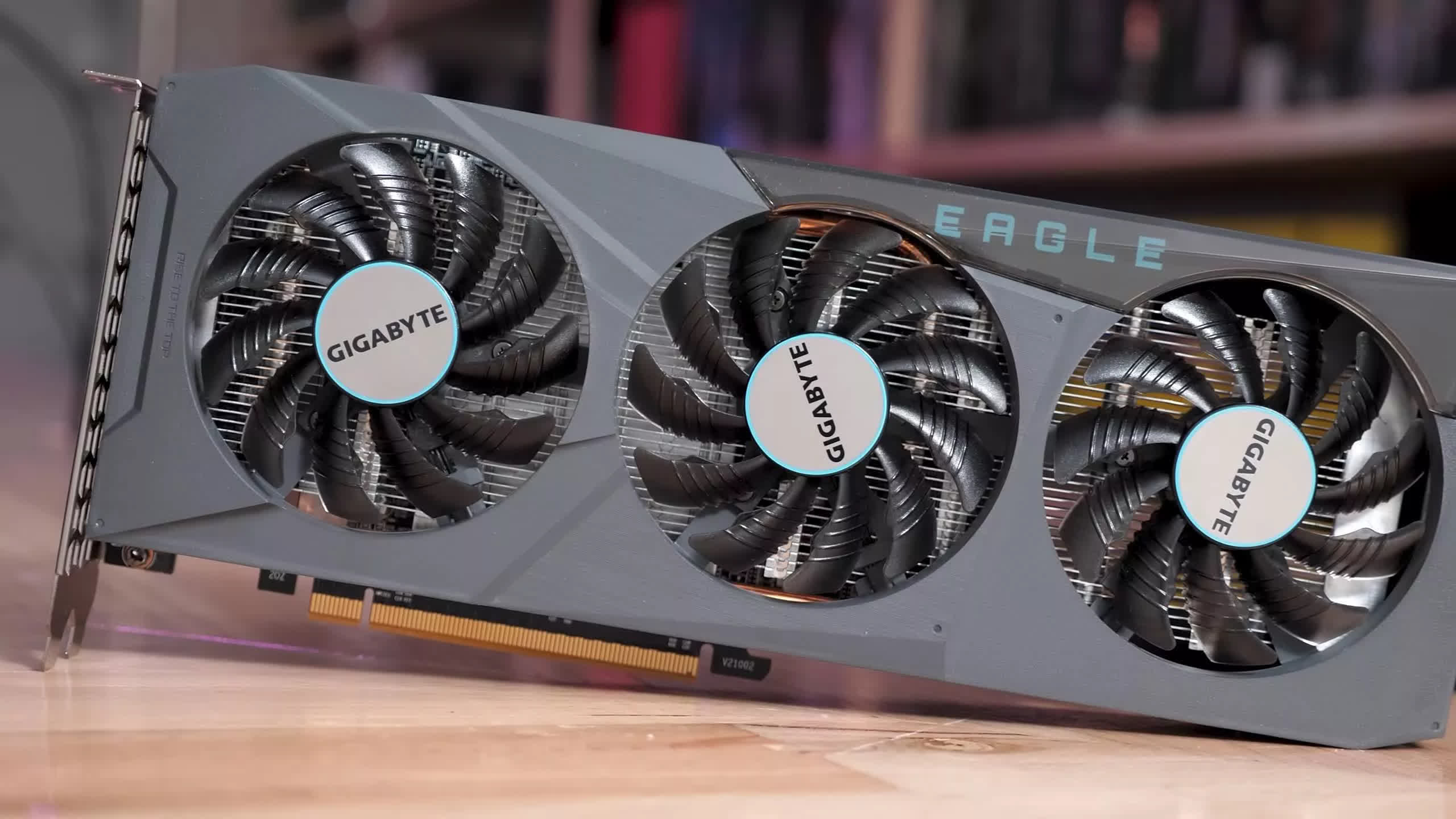
The mid-range is where Nvidia is most competitive and offers their best value product which right now is the GeForce RTX 3060 Ti, though generally speaking its cost per frame is not as strong as the competing Radeon RX 6700 XT / 6750 XT. These models are the most at risk of being superseded by future graphics cards soon, though their value is still strong, so we think people buying now won’t be stung too hard.
What does sting the most is the high end landscape. When we looked at MSRP pricing, it’s pretty clear that both Nvidia and AMD weren’t overly interested in making a big step forward in value with the new GeForce RTX 40 and Radeon RX 7000 GPU series. These new SKUs could have easily slotted into the previous series pricing structure, offering big performance gains alongside big price increases. We think this goes a long way to explain why people haven’t been excited by these new launches, and why models such as the GeForce RTX 4070 Ti and Radeon RX 7900 XT are sitting on shelves with relatively low demand.
To make matters worse, the two models that are the most interesting – the GeForce RTX 4090 and Radeon 7900 XTX – are only available at prices well above their MSRP. This reduces their value proposition further to the level where it’s just not worth considering them right now. This isn’t great for the Radeon 7900 XTX which at MSRP was positioned to be a better value version of the RTX 4080. Now that it’s priced closer to $1,300 at retail, it’s actually worse value than the RTX 4080 in cost per frame; and the 4080 is a horrific card for value.
However, there is plenty of time for AMD and Nvidia to adjust their pricing strategy and breathe some life, interest and demand into the GPU market. Slotting new cards into the existing price structure has been a fail so far; when we start getting mid-range GPUs it’s clear those cards need to deliver standout value.
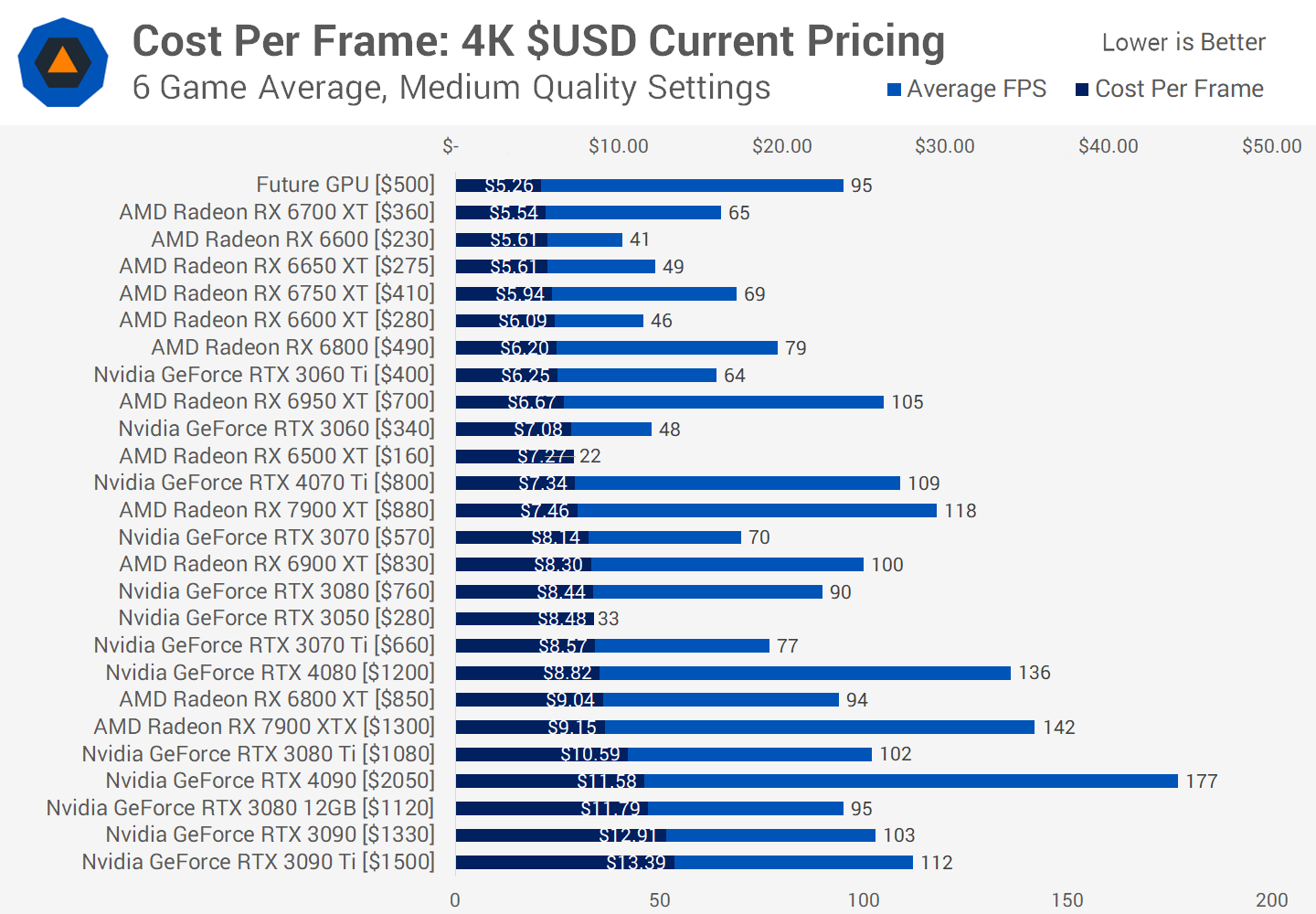
In our opinion, this is what a $500 GPU needs to look like in 2023 based on current value and pricing trends. This would be a vendor offering RTX 3080 12GB or Radeon 6800 XT levels of performance at around $500. This would blow other models out of the water in value, offering a 15% discount in cost per frame compared to the RX 6800, which is available around $500 right now, while also giving a healthy boost relative to the abundant Radeon 6700 series. We don’t think this is unreasonable given at launch the RTX 3070 offered a 27% discount in cost per frame relative to the similarly priced RTX 2070 Super, while also beating the Radeon 5700 XT in value by 16%.
A lesser but still passable target for $500 performance would be the equivalent of the GeForce RTX 3080, offering a 10% discount per frame relative to the Radeon 6800. But it’s questionable whether they would do that when we look at an MSRP comparison. Here this mythical future GPU would deliver a 26% discount per frame relative to the RTX 3070 at the same launch MSRP, so pretty similar to Ampere vs Turing in this price range. However it would mean we’re getting a card that’s only 13% slower than the GeForce RTX 4070 Ti at a 38% lower price, which isn’t in line with what GPU makers have done this generation so far.
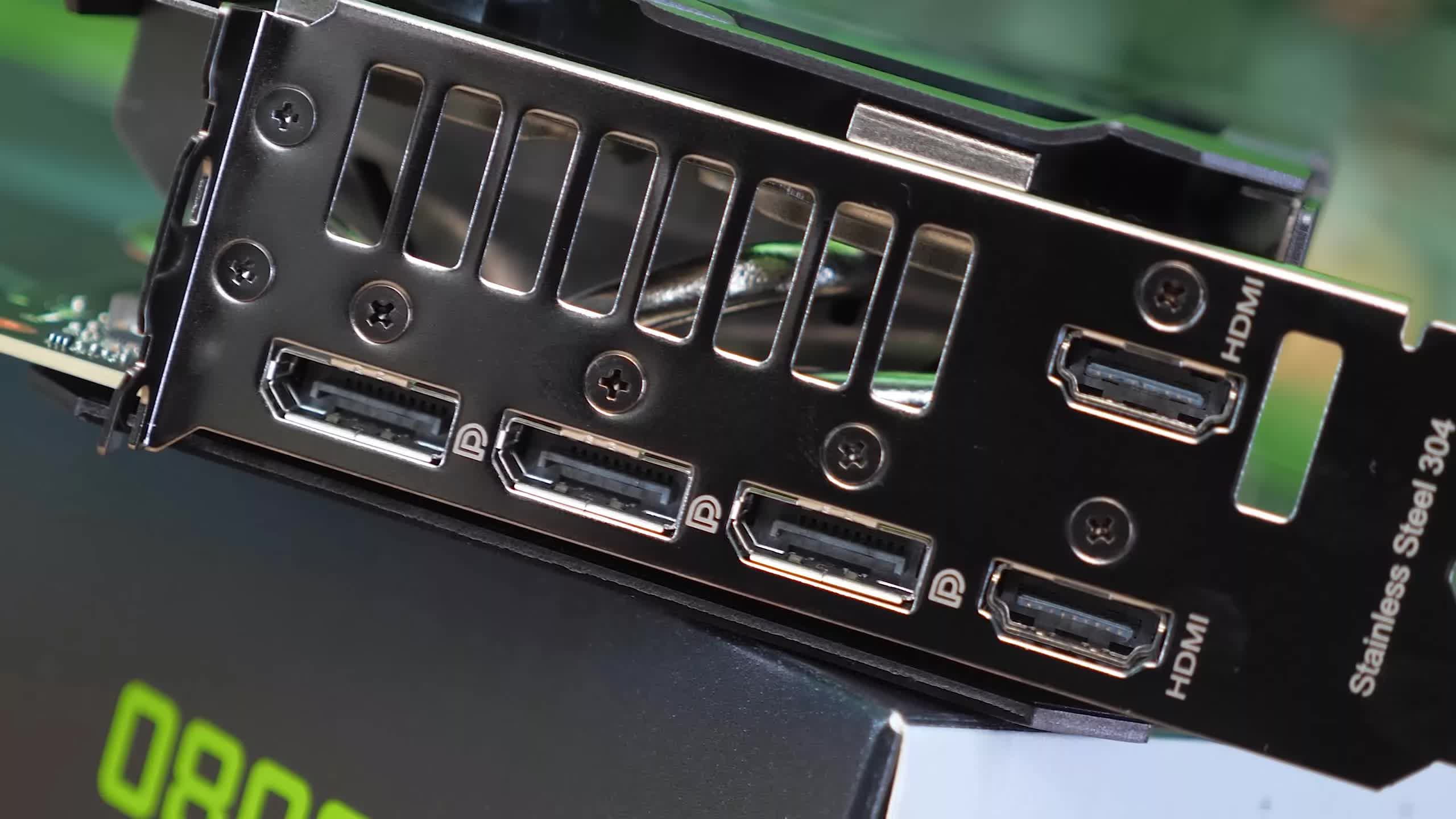
Unfortunately, what seems more realistic is a GPU that offers 5 more FPS than the GeForce RTX 3070 on average at the same price, leading to 7 percent discount in cost per frame. This is based on the RTX 4070 Ti offering a 6 percent discount per frame relative to the RTX 3080 at MSRP, while also noting the similarity in cost per frame between the Radeon 7900 XTX and 6800 XT. This sort of product would be better value than the RTX 3070 in the current market, but hard to recommend overall and the same sort of middling step forward we’ve seen so far this generation.
Fingers crossed we don’t see that sort of poor product come to fruition but anything is possible these days based on the value we’re seeing at the moment.

